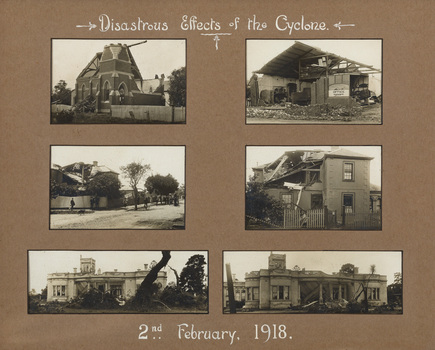Historical information
On 2nd February 1918, Brighton experienced the most extreme cyclone to hit a major Australian city, as recorded by the Commonwealth Bureau of Meteorology. With wind speeds estimated at 320 km/h and resulting in the deaths of two people, the event caused tremendous destruction in Brighton.
Physical description
Sepia photograph. Compilation of six sepia photographs in window mount of various buildings in Brighton that were damaged by the 1918 cyclone. Buildings include from L to R, top to bottom: Methodist Church, Hawthorn Road; Grant's Hay & Corn Store, Well Street; Wellington Street with Colonel Kendall's House on left; Colonel Kendall's House, Wellington Street; Billilla with fallen trees, Halifax Street; Billilla, Halifax Street.
Subjects
References
- "BRIGHTON DEVASTATED", Brighton Southern Cross, 9 February 1918, p. 4
- "Cyclone at Brighton, near Melbourne, on February 2", The Telegraph, 16 February 1918, p. 13
- "THE RECENT CYCLONE AT BRIGHTON", Bendigonian, 14 February 1918, p. 18
- "THE BRIGHTON CYCLONE: A RUINED CHURCH", Sydney Mail, 13 February 1918, p. 33
- "AT BRIGHTON", The Age, 4 February 1918, p. 7
- "FEROCIOUS STORM", The Argus, 4 February 1918, p. 9
- "DISASTROUS EFFECTS OF TORNADO AT BRIGHTON", The Mirror, 10 February 1918, p. 1.














